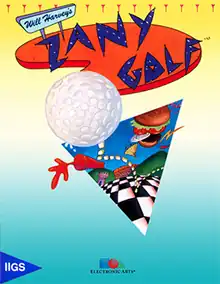Zany Golf
Zany Golf, also known as Will Harvey's Zany Golf, is a fantasy take on miniature golf developed by Sandcastle Productions and published by Electronic Arts in 1988. The game was originally written for the Apple IIGS and subsequently ported to the Amiga, Atari ST, and MS-DOS compatible operating systems. In 1990, a port was released for the Sega Genesis. The game was developed by Will Harvey, Ian Gooding, Jim Nitchals, and Douglas Fulton. Harvey was pursuing his advanced degrees at Stanford University at the time.
 | |
| Developer(s) | Sandcastle Productions |
|---|---|
| Publisher(s) | Electronic Arts |
| Designer(s) | Will Harvey Ian Gooding Jim Nitchals Douglas Fulton |
| Platform(s) | Apple IIGS Amiga, Atari ST, Genesis, MS-DOS |
| Genre(s) | Sports |
| Mode(s) | 1-4 players alternating |
The game is played in a 3D isometric viewpoint and allows up to 4 players. Zany Golf consists of half a golf course—nine holes—plus a bonus hole.
Gameplay
At the beginning of the first hole, all players are given five strokes. On completing each hole, the remaining players are given more strokes equal to the par of the next hole. Any player who runs out of strokes is eliminated, and the other players are allowed to continue. The game ends when all players are eliminated or when the last hole is completed, and the scorecard is displayed.

On all versions except the Genesis version, the mouse is used to shoot the ball by clicking on it, pulling back in the reverse direction of the eventual shot, and releasing. On occasion, fairies are placed on the course; hitting them awards anywhere from 1 to 5 bonus strokes. Also, a timer bonus may be possible. If the hole is finished quickly, the player may earn up to four bonus strokes. If a fairy is present or a timer bonus is available, it will be announced prior to the first shot.
Up to four players can play the game by taking turns, with player 1 having a red ball, player 2 a blue ball, player 3 a black ball, and player 4 a white ball. Once a player's turn is complete, it disappears from the course and is replaced by an X mark of that player's color, which cannot be disrupted by other players' balls. Multiple players can work together to hit the necessary targets on the Pinball and Energy holes. Once the drop targets or computer buttons have been hit, they need not be hit by any other player.
Ports
Due to the lack of a mouse or similar pointing device, the Sega Genesis edition of the game omitted the "Magic Carpet" hole. Instead, the 'Mystery' bonus hole from the computer game appears after "Ant Hill," although it was renamed "Knockout Nightmare."
The DOS version uses a code wheel as a form of copy protection. Before the Hamburger hole, the game gives a prompt which requires the player to rotate the wheel into a certain position. Giving the correct result allows the player to continue the game.
The musical score in the original version uses the 15-voice Ensoniq audio chip in the Apple IIGS computer. Ports considerably scale down the music quality.
Reception
The game was reviewed in 1989 in Dragon #144 by Hartley, Patricia, and Kirk Lesser in "The Role of Computers" column. The reviewers gave the game 5 out of 5 stars.[1] Compute! described Zany Golf as "a moderately challenging game with topnotch graphics and sound".[2]
Reviews
- Amiga Computing (May, 1989)[3]
- Computer and Video Games (Dec, 1990)[4]
- The Games Machine (May, 1989)[5]
- The Games Machine (Apr, 1989)[6]
- Computer and Video Games (Mar, 1989)[7]
- Zzap! (Apr, 1989)[8]
- Commodore User (Apr, 1989)[9]
- Raze (Jan, 1991)[10]
- Mean Machines (Nov, 1990)[11]
- Power Play (1989)[12]
- Power Play (Mar, 1989)[13]
- The One (Mar, 1989)[14]
- ACE (Advanced Computer Entertainment) (May, 1989)[15]
- ACE (Advanced Computer Entertainment) (Apr, 1989)[16]
- Génération 4 (Feb, 1991)[17]
- Tilt (Apr, 1991)[17]
- Amiga User International (Apr, 1989)[18]
- ACE (Advanced Computer Entertainment) (Apr, 1991)[19]
- Antic's Amiga Plus (Feb, 1990)[20]
- ASM (Aktueller Software Markt) (Mar, 1989)[21]
References
- Lesser, Hartley; Lesser, Patricia; Lesser, Kirk (April 1989). "The Role of Computers". Dragon (144): 60–68.
- English, David (July 1989). "Zany Golf". Compute!. p. 71. Retrieved 11 November 2013.
- "Amiga Reviews: Zany Golf". amigareviews.leveluphost.com.
- Computer Games Magazine
- "The Games Machine Issue 18" – via Internet Archive.
- "The Games Machine Magazine Issue 17".
- "CVG Magazine Issue 089". March 1989.
- "ZZap!64 Magazine Issue 048". April 1989.
- "Commodore User Magazine Issue 67". April 1989.
- "RAZE - Issue 03 (1991-01)(Newsfield Publishing)(GB)". January 1991.
- Mean Machines. Zany Golf
- "Kultpower Archiv: Komplettscan Powerplay best of 1989". www.kultpower.de.
- "Kultpower Archiv: Komplettscan Powerplay 4/1989".
- "TheOne Magazine Issue 06". March 1989.
- "ACE Magazine Issue 20". May 1989.
- "ACE Magazine Issue 19". April 1989.
- "Le site des anciennes revues informatiques - www.abandonware-magazines.org". www.abandonware-magazines.org.
- "Zany Golf review from AUI Vol 3 No 4 (Apr 1989) - Amiga Magazine Rack".
- "ACE Magazine Issue 43". April 1991.
- "Will Harvey's Zany Golf review from Antic's Amiga Plus Vol 1 No 6 (Feb - Mar 1990) - Amiga Magazine Rack". amr.abime.net.
- "Kultboy.com - DIE Kult-Seite über die alten Spiele-Magazine und Retro-Games!". www.kultboy.com.